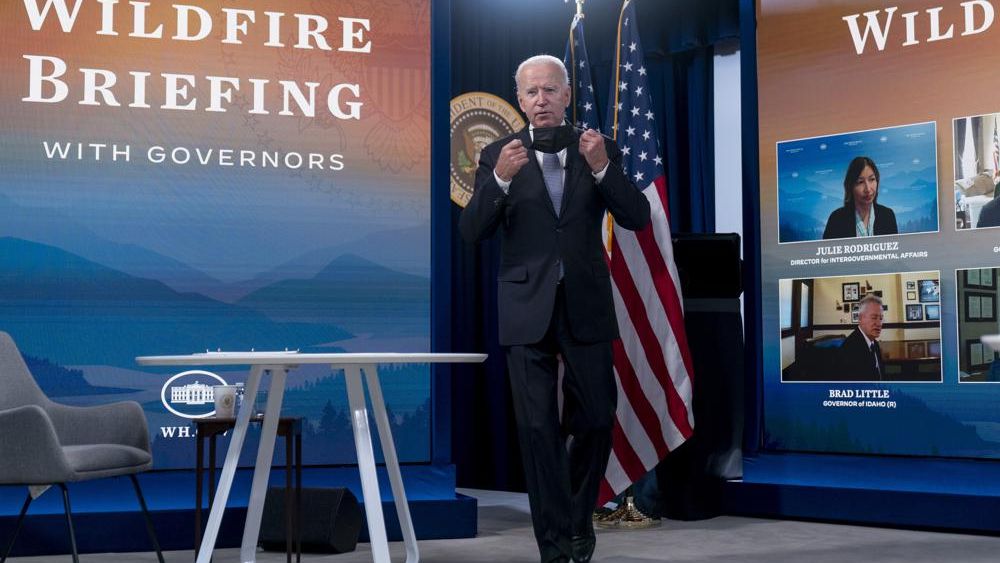President Joe Biden and Vice President on Friday convened a bipartisan group of governors whose states have all been impacted by the already devastating fire season across the United States.
Gathered virtually were Govs. Greg Gianforte, R-Mont., Brad Little, R-Idaho, Mark Gordon, R-Wyo., Kate Brown, D-Ore., Jay Inslee, D-Wash., Gavin Newsom, D-Calif. and Tim Walz, D-Minn.
Friday’s meeting was the second of what will be a regular briefing on wildfire preparedness between President Joe Biden and various governors as the administration works to better partner with states dealing with the issue.
“I said then that the threat of Western wildfires this year was as severe as it's ever been,” Biden said of his first such meeting. “And in the past month we’ve sadly seen the truth of that being played out. Since our last meeting, the number of large, uncontained wildfires has nearly doubled to 66.”
According to the National Interagency Fire Center, upwards of 1.7 million acres are currently burning across 13 states. Since the start of the year, nearly 2.9 million acres have been destroyed by wildfires, predominantly in the western United States and along the Canadian border.
The president asked governors directly what his administration can do to better help their states prepare for, deal with and recover from wildfires.
“We’re in for a long fight yet this year, and the only way we are going to beat those challenges is by working together,” the president said. “Wildfires are a problem for all of us and we have to stay closely coordinated and do everything we can for our people.”
“That's why I asked the governors to join us, Democrats and Republicans alike, so they can update me and the vice president directly on what they need and what we possibly can do more of,” he added.
Montana Gov. Gianforte was the first to respond, saying firefighters are currently battling 19 large-scale fires across the state.
Gianforte noted there are many forests in Montana which, due to poor maintenance, previous fires, bug infestations, drought or other reasons, contain little to no living plant life. This creates a natural “tinderbox situation,” Gianforte said, which puts both civilian and firefighters’ lives in danger.
Given these conditions, Gianforte stressed the need for year-round forest management to clear away dead trees and other flammable materials. By logging certain areas and using techniques like prescribed burns, many devastating fires could be avoided altogether, he noted.
“We ask that our federal partners join us in applying this operating principle. Whether it's a fire that starts on private, state or federal land, fires are easier to manage when they’re smaller,” Gianforte said, acknowledging that the state already has good working relationships with its federal partners in the Bureau of Land Management.
The need for proper year-round forest management had widely bipartisan support, with several governors asking for more federal support in order to do so.
Washington Gov. Jay Inslee, who has long been an outspoken advocate for green policies, agreed that there is “anonymity, there is bipartisan acceptance of the need for active management,” also saying there should be a new workforce to deal with climate-related issues and more aerial assets to fight fires.
“The thing I worry most about is if for some reason the congress did not follow your leadership in this reconciliation and infrastructure bills that allowed you to realize your vision in creating millions of jobs while fighting climate change,” Inslee added. “That’s my biggest worry right now.”
The president similarly took a moment to tout the bipartisan infrastructure deal currently making its way through Congress, saying: “One of the important aspects of the bipartisan infrastructure deal...is that it includes billions of dollars to strengthen wildfire preparedness, resilience, and response.”
“It includes funding for prevention efforts, like forest management, and will restore millions of acres og high risk areas to protect homes and public water sources for drinking,” Biden continued. “Overlaying all of this is the necessity to successfully confront climate change.”
Climate change-curbing investments are tucked into a few key sections of the currently-negotiated infrastructure package, including $7.5 billion for electric vehicle charging stations, which the administration says is critical to accelerating the use of electric vehicles to curb climate change; $5 billion for the purchase of electric school buses and hybrids, reducing reliance on school buses that run on diesel fuel; $21 billion to clean up superfund and brownfield sites, reclaim abandoned mine land and cap obsolete gas wells and $73 billion for modernizing the nation’s electric grid and expanding the use of renewable energy.
The Associated Press contributed to this report.



